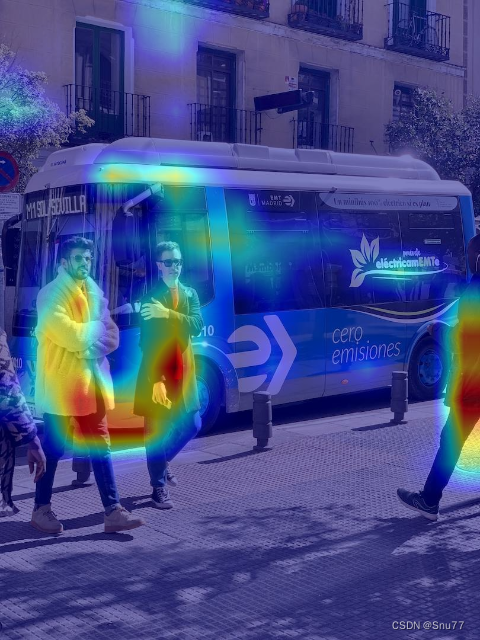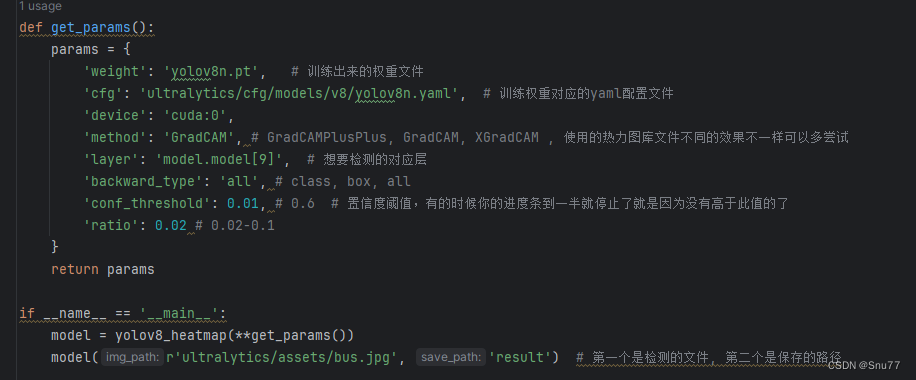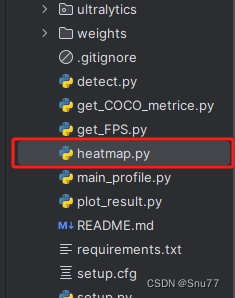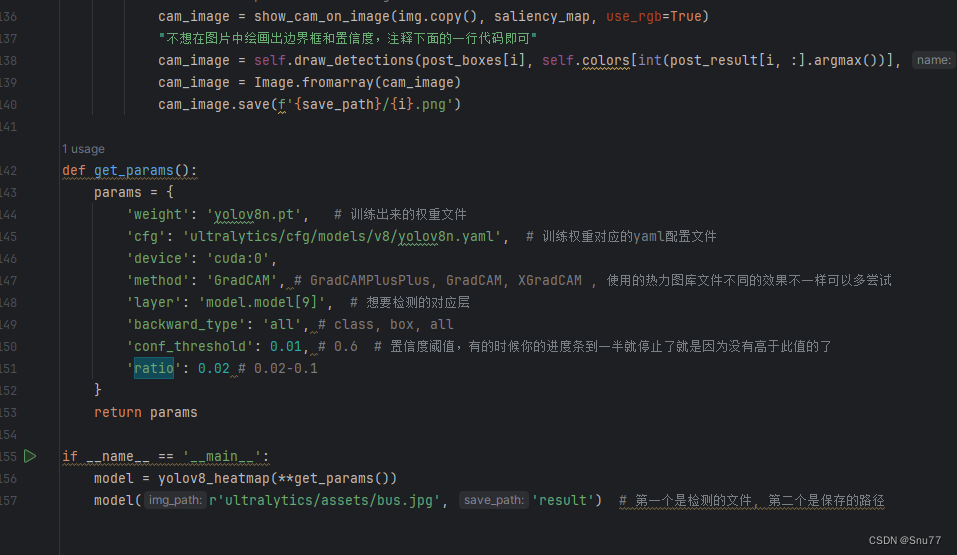# 一、本文介绍
本文给大家带来的机制是的可视化热力图功能,热力图) 作为我们论文当中的必备一环,可以展示出我们呈现机制的有效性,本文的内容支持 YOLOv8 最新版本,同时支持视频讲解,本文的内容是根据检测头的输出内容,然后来绘图,产生 6300 张预测图片,从中选取出有效的热力图来绘图。
在开始之前给大家推荐一下我的专栏,本专栏每周更新 3-10 篇最新前沿机制 | 包括二次创新全网无重复,以及融合改进 (大家拿到之后添加另外一个改进机制在你的数据集上实现涨点即可撰写论文),还有各种前沿顶会改进机制 |,更有包含我所有附赠的文件(文件内集成我所有的改进机制全部注册完毕可以直接运行)和交流群和视频讲解提供给大家。

# 二、项目完整代码
我们将这个代码,复制粘贴到我们 YOLOv8 的仓库里然后创建一个 py 文件存放进去即可。
import warnings | |
warnings.filterwarnings('ignore') | |
warnings.simplefilter('ignore') | |
import torch, yaml, cv2, os, shutil | |
import numpy as np | |
np.random.seed(0) | |
import matplotlib.pyplot as plt | |
from tqdm import trange | |
from PIL import Image | |
from ultralytics.nn.tasks import DetectionModel as Model | |
from ultralytics.utils.torch_utils import intersect_dicts | |
from ultralytics.utils.ops import xywh2xyxy | |
from pytorch_grad_cam import GradCAMPlusPlus, GradCAM, XGradCAM | |
from pytorch_grad_cam.utils.image import show_cam_on_image | |
from pytorch_grad_cam.activations_and_gradients import ActivationsAndGradients | |
def letterbox(im, new_shape=(640, 640), color=(114, 114, 114), auto=True, scaleFill=False, scaleup=True, stride=32): | |
# Resize and pad image while meeting stride-multiple constraints | |
shape = im.shape[:2] # current shape [height, width] | |
if isinstance(new_shape, int): | |
new_shape = (new_shape, new_shape) | |
# Scale ratio (new / old) | |
r = min(new_shape[0] / shape[0], new_shape[1] / shape[1]) | |
if not scaleup: # only scale down, do not scale up (for better val mAP) | |
r = min(r, 1.0) | |
# Compute padding | |
ratio = r, r # width, height ratios | |
new_unpad = int(round(shape[1] * r)), int(round(shape[0] * r)) | |
dw, dh = new_shape[1] - new_unpad[0], new_shape[0] - new_unpad[1] # wh padding | |
if auto: # minimum rectangle | |
dw, dh = np.mod(dw, stride), np.mod(dh, stride) # wh padding | |
elif scaleFill: # stretch | |
dw, dh = 0.0, 0.0 | |
new_unpad = (new_shape[1], new_shape[0]) | |
ratio = new_shape[1] / shape[1], new_shape[0] / shape[0] # width, height ratios | |
dw /= 2 # divide padding into 2 sides | |
dh /= 2 | |
if shape[::-1] != new_unpad: # resize | |
im = cv2.resize(im, new_unpad, interpolation=cv2.INTER_LINEAR) | |
top, bottom = int(round(dh - 0.1)), int(round(dh + 0.1)) | |
left, right = int(round(dw - 0.1)), int(round(dw + 0.1)) | |
im = cv2.copyMakeBorder(im, top, bottom, left, right, cv2.BORDER_CONSTANT, value=color) # add border | |
return im, ratio, (dw, dh) | |
class yolov8_heatmap: | |
def __init__(self, weight, cfg, device, method, layer, backward_type, conf_threshold, ratio): | |
device = torch.device(device) | |
ckpt = torch.load(weight) | |
model_names = ckpt['model'].names | |
csd = ckpt['model'].float().state_dict() # checkpoint state_dict as FP32 | |
model = Model(cfg, ch=3, nc=len(model_names)).to(device) | |
csd = intersect_dicts(csd, model.state_dict(), exclude=['anchor']) # intersect | |
model.load_state_dict(csd, strict=False) # load | |
model.eval() | |
print(f'Transferred {len(csd)}/{len(model.state_dict())} items') | |
target_layers = [eval(layer)] | |
method = eval(method) | |
colors = np.random.uniform(0, 255, size=(len(model_names), 3)).astype(np.int32) | |
self.__dict__.update(locals()) | |
def post_process(self, result): | |
logits_ = result[:, 4:] | |
boxes_ = result[:, :4] | |
sorted, indices = torch.sort(logits_.max(1)[0], descending=True) | |
return torch.transpose(logits_[0], dim0=0, dim1=1)[indices[0]], torch.transpose(boxes_[0], dim0=0, dim1=1)[indices[0]], xywh2xyxy(torch.transpose(boxes_[0], dim0=0, dim1=1)[indices[0]]).cpu().detach().numpy() | |
def draw_detections(self, box, color, name, img): | |
xmin, ymin, xmax, ymax = list(map(int, list(box))) | |
cv2.rectangle(img, (xmin, ymin), (xmax, ymax), tuple(int(x) for x in color), 2) | |
cv2.putText(img, str(name), (xmin, ymin - 5), cv2.FONT_HERSHEY_SIMPLEX, 0.8, tuple(int(x) for x in color), 2, lineType=cv2.LINE_AA) | |
return img | |
def __call__(self, img_path, save_path): | |
# remove dir if exist | |
if os.path.exists(save_path): | |
shutil.rmtree(save_path) | |
# make dir if not exist | |
os.makedirs(save_path, exist_ok=True) | |
# img process | |
img = cv2.imread(img_path) | |
img = letterbox(img)[0] | |
img = cv2.cvtColor(img, cv2.COLOR_BGR2RGB) | |
img = np.float32(img) / 255.0 | |
tensor = torch.from_numpy(np.transpose(img, axes=[2, 0, 1])).unsqueeze(0).to(self.device) | |
# init ActivationsAndGradients | |
grads = ActivationsAndGradients(self.model, self.target_layers, reshape_transform=None) | |
# get ActivationsAndResult | |
result = grads(tensor) | |
activations = grads.activations[0].cpu().detach().numpy() | |
# postprocess to yolo output | |
post_result, pre_post_boxes, post_boxes = self.post_process(result[0]) | |
for i in trange(int(post_result.size(0) * self.ratio)): | |
if float(post_result[i].max()) < self.conf_threshold: | |
break | |
self.model.zero_grad() | |
# get max probability for this prediction | |
if self.backward_type == 'class' or self.backward_type == 'all': | |
score = post_result[i].max() | |
score.backward(retain_graph=True) | |
if self.backward_type == 'box' or self.backward_type == 'all': | |
for j in range(4): | |
score = pre_post_boxes[i, j] | |
score.backward(retain_graph=True) | |
# process heatmap | |
if self.backward_type == 'class': | |
gradients = grads.gradients[0] | |
elif self.backward_type == 'box': | |
gradients = grads.gradients[0] + grads.gradients[1] + grads.gradients[2] + grads.gradients[3] | |
else: | |
gradients = grads.gradients[0] + grads.gradients[1] + grads.gradients[2] + grads.gradients[3] + grads.gradients[4] | |
b, k, u, v = gradients.size() | |
weights = self.method.get_cam_weights(self.method, None, None, None, activations, gradients.detach().numpy()) | |
weights = weights.reshape((b, k, 1, 1)) | |
saliency_map = np.sum(weights * activations, axis=1) | |
saliency_map = np.squeeze(np.maximum(saliency_map, 0)) | |
saliency_map = cv2.resize(saliency_map, (tensor.size(3), tensor.size(2))) | |
saliency_map_min, saliency_map_max = saliency_map.min(), saliency_map.max() | |
if (saliency_map_max - saliency_map_min) == 0: | |
continue | |
saliency_map = (saliency_map - saliency_map_min) / (saliency_map_max - saliency_map_min) | |
# add heatmap and box to image | |
cam_image = show_cam_on_image(img.copy(), saliency_map, use_rgb=True) | |
"不想在图片中绘画出边界框和置信度,注释下面的一行代码即可" | |
cam_image = self.draw_detections(post_boxes[i], self.colors[int(post_result[i, :].argmax())], f'{self.model_names[int(post_result[i, :].argmax())]} {float(post_result[i].max()):.2f}', cam_image) | |
cam_image = Image.fromarray(cam_image) | |
cam_image.save(f'{save_path}/{i}.png') | |
def get_params(): | |
params = { | |
'weight': 'yolov8n.pt', # 训练出来的权重文件 | |
'cfg': 'ultralytics/cfg/models/v8/yolov8n.yaml', # 训练权重对应的 yaml 配置文件 | |
'device': 'cuda:0', | |
'method': 'GradCAM', # GradCAMPlusPlus, GradCAM, XGradCAM , 使用的热力图库文件不同的效果不一样可以多尝试 | |
'layer': 'model.model[9]', # 想要检测的对应层 | |
'backward_type': 'all', # class, box, all | |
'conf_threshold': 0.01, # 0.6 # 置信度阈值,有的时候你的进度条到一半就停止了就是因为没有高于此值的了 | |
'ratio': 0.02 # 0.02-0.1 | |
} | |
return params | |
if __name__ == '__main__': | |
model = yolov8_heatmap(**get_params()) | |
model(r'ultralytics/assets/bus.jpg', 'result') # 第一个是检测的文件,第二个是保存的路径 |
# 三、参数解析
下面上面项目核心代码的参数解析,共有 7 个,能够起到作用的参数并不多。

| 参数名 | 参数类型 | 参数讲解 | |
|---|---|---|---|
| 0 | weights | str | 用于检测视频的权重文件地址(可以是你训练好的,也可以是官方提供的) |
| 1 | cfg | str | 你选择的权重对应的 yaml 配置文件,请注意一定要对应否则会报错和不显示图片 |
| 2 | device | str | 设备的选择可以用 GPU 也可以用 CPU |
| 3 | method | str | 使用的热力图第三方库的版本,不同的版本效果也不一样。 |
| 4 | layer | str | 想要检测的对应层,比如这里设置的是 9 那么检测的就是第九层 |
| 4 | backward_type | str | 检测的类别 |
| 5 | conf_threshold | str | 置信度阈值,有的时候你的进度条没有满就是因为没有大于这个阈值的图片了 |
| 6 | ratio | int | YOLOv8 一次产生 6300 张预测框,选择多少比例的图片绘画热力图。 |
# 四、项目的使用教程
# 4.1 步骤一
我们在 Yolo 仓库的目录下创建一个 py 文件将代码存放进去,如下图所示。

# 4.2 步骤二
我们按照参数解析部分的介绍填好大家的参数,主要配置的有两个一个就是权重文件地址另一个就是图片的地址。

# 4.3 步骤三
我们挺好之后运行文件即可,图片就会保存在同级目录下的新的文件夹 result 内。

# 4.4 置信度和检测框
看下下面的说明就行。

